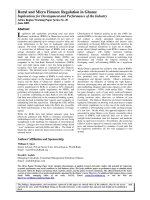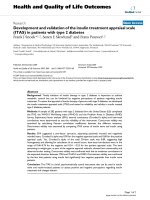Information system development p1the world of the information systems analyst
Bạn đang xem bản rút gọn của tài liệu. Xem và tải ngay bản đầy đủ của tài liệu tại đây (487.05 KB, 32 trang )
Matakuliah
Tahun
: M0054 Information System Development
: 2012
Meeting 1
The World of the Information
Systems Analyst
Rules
Read
active
Bina Nusantara
assignments
only
On time!
ask questions.
What is this course about?
•
•
Structure methodology for developing information system.
Analysis and designing information system by using a structure system methodology.
Objectives
• Explain the system analyst role in developing the information system
• Explain the system development life cycle and some techniques for
information gathering
• Explain the use case table and entity relational diagram
• Explain how to create a Data Flow Diagram (DFD)
• Design a structure chart and pseudo code
Evaluation and Grading
Grading Formula and System
30% Mid Exam
30% Final Exam
40% Assignments
Total possible 100%
Bina Nusantara
Requirements
On time!
Bina Nusantara
PERMISSION TO LEAVE
PROHIBITED BEHAVIOUR
Readings and Screenings
Readings
•
John Satzinger, Robert Jackson, Stephen Burd (2007). Systems analysis and design in a changing world 07. Course Technology. -. ISBN:
9781423902287.
•
Simon, B., Skelton, H., & Farmer, R. (2006). Object-Oriented Systems Analysis and Design UML. 03. McGraw Hill. Singapore. ISBN: 0-07711000-5.
Online Reading
•
•
•
•
/> /> /> />
Bina Nusantara
The world of the
Information system analyst
Points to discuss :
•
•
•
•
•
•
The Analyst as a Business Problem Solver
Systems That Solve Business Problems
Types of Information System
Required Skills of the System Analyst
RMO and Its Strategic Information System Plan
Analyst as a System Developer
Bina Nusantara
The Analyst as a Business Problem Solver
•
Has computer technology knowledge and programming expertise
•
Understands business problems
•
Uses logical methods for solving problems
•
Has fundamental curiosity
•
Wants to make things better
•
Is more of a business problem solver than a technical programmer
Analyst’s Approach to
Problem Solving
(Continued)
Research and understand the problem
Verify benefits of solving problem outweigh the costs
Define the requirements for solving the problem
Develop a set of possible solutions (alternatives)
Decide which solution is best and recommend
Define the details of the chosen solution
Implement the solution
Monitor to ensure desired results
Systems That Solve Business Problems
•
System – a collection of interrelated components
functioning together to
achieve an outcome
•
Information systems – collection of interrelated
that collect, process, store,
components
and provide as output the information
needed to complete business tasks
•
Subsystem – part of a larger system
•
Functional decomposition – dividing a system into
subsystems and components
smaller
Information Systems
Subsystems
Types of
Information Systems
Required Skills
of the Systems Analyst
Technical Knowledge and Skills
•
An analyst should have fundamental technology knowledge of
–
–
–
–
–
–
Computers / peripheral devices (hardware)
Files and database systems
Input and output components and alternatives
Computer networks and protocols
Programming languages, operating systems, and utilities
Communication and collaboration technology
Technical Knowledge and Skills (continued)
•
•
Analyst uses tools
–
Software productivity packages
–
Integrated development environments (IDEs) for programming languages
–
Visual modelling tools and code generation tools
Analyst understands SDLC techniques
–
Project planning, cost/benefit, interviewing
–
Systems requirements modelling
–
Design, database design, network configuration
Business
Knowledge and Skills
•
•
Analyst must understand
–
Business functions performed by organization
–
Strategies, plans, traditions, and values of the organization
–
Organizational structure
–
Organization management techniques
–
Functional work processes
Systems analysts typically study business administration/management in
college with a major in CIS or MIS
People
Knowledge and Skills
•
Primarily a systems analyst must be an effective communicator
•
A systems analyst must be able to perform various roles such as negotiator,
teacher, mentor, collaborator, and manager
Integrity and Ethics
•
Analyst has access to confidential information, such as salary, an organization’s
planned projects, security systems, and so on.
–
Must keep information private
–
Any impropriety can ruin an analyst’s career
–
An analyst plans the security in systems to protect confidential information
Systems Analyst
Related Careers
•
Employment picture is complex with traditional programming jobs not as
prevalent as previously
•
Many new opportunities exist in areas such as consulting, compliance, security,
Web development, ERP support
•
Typical job titles include:
–
Consultant – Business, Systems, Technical
–
Analyst – Business systems, Systems support
–
Developer – Web, systems
–
Architect – Web, System, Software
The Analyst’s Role
in Strategic Planning
•
Special projects affecting executives
–
Business process management – redesign and improvements to existing
processes
•
•
Strategic planning process
Information systems strategic planning
–
Application architecture plan (business focus)
–
Technology architecture plan (infrastructure focus)
Components of
an Information Systems
Strategic Plan
Rocky Mountain Outfitters (RMO) and Its Strategic Information
Systems Plan
•
RMO sports clothing manufacturer and distributor about to begin customer support
system project
•
Need to understand the nature of the business, approach to strategic planning, and
objectives for customer support system
•
•
RMO system development project used to demonstrate analysis and design concepts
Reliable Pharmaceutical Service (RPS) is a second case study for classroom purposes
Introduction to Rocky Mountain Outfitters (RMO) Business
•
Began in Park City, Utah supplying winter sports clothes to local ski shops
•
Expanded into direct mail-order sales with small catalog—as catalog interest
increased, opened retail store in Park City
•
Became large, regional sports clothing distributor by early 2000s in Rocky Mountain
and Western states
•
Currently $180 million in annual sales and 600 employees and two retail stores
•
Mail-order revenue is $90 million; phone-order revenue is $50 million
Early RMO Catalog Cover (Fall 1978)
Current RMO Catalog Cover (Fall 2007)









